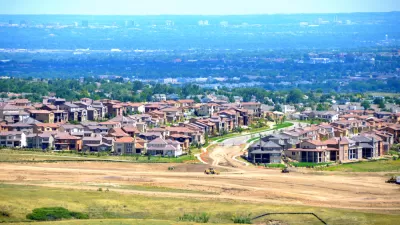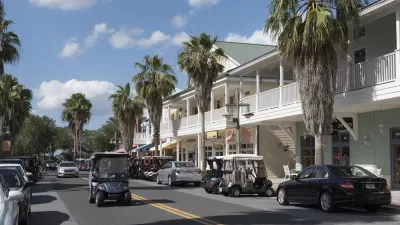Describing a seminar on "Sprawl and the Law" at the University of Pittsburgh.

This year, for the first time in several years, I taught a seminar on sprawl and the law. In the past, I had generally taught this course at Florida Coastal School of Law in Jacksonville. Because Jacksonville had been growing rather than shrinking, I focused primarily on policies that made Sun Belt cities automobile-oriented, such as minimum lot size requirements and wide streets.
By contrast, this year I am visiting at the University of Pittsburgh's law school. Since Pittsburgh has lost more than half its 1950 population, I focused on the decline of the central city (although we did spend a few weeks on urban form at the end of the course). But because I was teaching in a law school, I still had to find ways of addressing legal issues relevant to that question.
After spending the first week defining sprawl and explaining why it is controversial, I focused on one obvious driver of sprawl (pun intended): highways that facilitate suburban development. In addition to discussing the policy issues related to highways, I discussed environmental groups' (mostly unsuccessful) attempts to use the law to limit highway development, such as suits under the National Environmental Policy Act and the "disparate impact" provisions of the civil rights legislation.
Then we discussed public transit—not so much as a means of limiting sprawl, but more as a means of mitigating the negative aspects of sprawl (such as the negative effects of sprawl on the carless poor and disabled). We had a speaker from the local transit agency and a local transit advocacy group, and we learned about Pennsylvania’s transit financing system, which restricts local taxation powers and thus makes cities and counties dependent on the largesse of state government. Again, we discussed legal issues related to transit- in particular, litigants' unsuccessful attempts to use the Americans with Disabilities Act and civil rights law to protect transit service (and in one case, to shift transit funding from trains to buses).
Then we discussed land use regulation as a possible remedy for sprawl. We of course discussed growth control measures such as Oregon's urban growth boundaries and constitutional litigation related to growth control. For the first time, we began to discuss land use regulation as a driver of suburbanization—for example, regulations that limit urban housing supply and thus price people out of cities.
Finally, we discussed one area that was especially important to Pittsburgh-education policy. In Pittsburgh, as in many other cities, city schools deter families from living in the urban core. We began by studying a Supreme Court case upholding school district residency requirements. After reading the case we discussed its negative impact upon the city: it means that parents who prefer suburban schools have to move to the suburbs to get those schools.
We also discussed the results of school desegregation litigation; in the early 1970s, the federal courts required city school districts to create racially balanced schools, but imposed no similar obligations on most suburbs. Because in those days, class and race tended to go together to an even greater extent than is the case today, parents who wanted schools filled with children from middle-class backgrounds could not get what they wanted even if they lived in the richest urban neighborhoods. Needless to say, this made suburban schools more appealing.
Pittsburgh seems to be somewhat less unsuccessful in this regard than some other Rust Belt school districts; there is at least one high school that appears to be able to attract middle-class students. I was disappointed that I was not able to get a speaker on Pittsburgh’s desegregation process.
Because we spent more time on city vs. suburb issues than in earlier versions of the seminar, some things got cut back. Because the school was located in an urban neighborhood, I didn’t think we needed field trips to urban neighborhoods. (By contrast, in Jacksonville, the city was so dominated by sprawl that I assumed students had little familiarity with walkable areas, so I ran field trips to one or two of the city’s more walkable areas.)
So far I have only received rough drafts of most student papers, but the papers seem quite intriguing so far. Paper topics include the relationship between urbanization and war tactics, a novel about Swedish suburbia, public schools in Pittsburgh’s poorer suburbs, the fall and rebirth of downtown Dallas, and some local planning issues.

Maui's Vacation Rental Debate Turns Ugly
Verbal attacks, misinformation campaigns and fistfights plague a high-stakes debate to convert thousands of vacation rentals into long-term housing.

Planetizen Federal Action Tracker
A weekly monitor of how Trump’s orders and actions are impacting planners and planning in America.

In Urban Planning, AI Prompting Could be the New Design Thinking
Creativity has long been key to great urban design. What if we see AI as our new creative partner?

King County Supportive Housing Program Offers Hope for Unhoused Residents
The county is taking a ‘Housing First’ approach that prioritizes getting people into housing, then offering wraparound supportive services.

Researchers Use AI to Get Clearer Picture of US Housing
Analysts are using artificial intelligence to supercharge their research by allowing them to comb through data faster. Though these AI tools can be error prone, they save time and housing researchers are optimistic about the future.

Making Shared Micromobility More Inclusive
Cities and shared mobility system operators can do more to include people with disabilities in planning and operations, per a new report.
Urban Design for Planners 1: Software Tools
This six-course series explores essential urban design concepts using open source software and equips planners with the tools they need to participate fully in the urban design process.
Planning for Universal Design
Learn the tools for implementing Universal Design in planning regulations.
planning NEXT
Appalachian Highlands Housing Partners
Mpact (founded as Rail~Volution)
City of Camden Redevelopment Agency
City of Astoria
City of Portland
City of Laramie






























